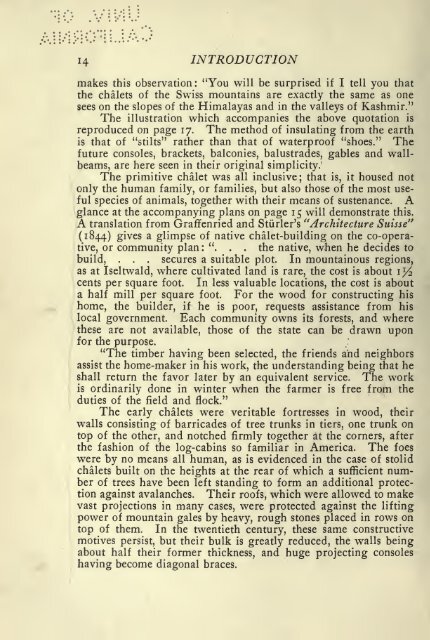The Swiss chalet book; a minute analysis and reproduction of the ...
The Swiss chalet book; a minute analysis and reproduction of the ...
The Swiss chalet book; a minute analysis and reproduction of the ...
You also want an ePaper? Increase the reach of your titles
YUMPU automatically turns print PDFs into web optimized ePapers that Google loves.
i 4<br />
INTRODUCTION<br />
makes this observation: "You will be surprised if I tell you that<br />
<strong>the</strong> <strong>chalet</strong>s <strong>of</strong> <strong>the</strong> <strong>Swiss</strong> mountains are exactly <strong>the</strong> same as one<br />
sees on <strong>the</strong> slopes <strong>of</strong> <strong>the</strong> Himalayas <strong>and</strong> in <strong>the</strong> valleys <strong>of</strong> Kashmir."<br />
<strong>The</strong> illustration which accompanies <strong>the</strong> above quotation is<br />
reproduced on page 17. <strong>The</strong> method <strong>of</strong> insulating from <strong>the</strong> earth<br />
is that <strong>of</strong> "stilts" ra<strong>the</strong>r than that <strong>of</strong> waterpro<strong>of</strong> "shoes." <strong>The</strong><br />
future consoles, brackets, balconies, balustrades, gables <strong>and</strong> wall-<br />
beams, are here seen in <strong>the</strong>ir original simplicity.<br />
<strong>The</strong> primitive <strong>chalet</strong> was all inclusive; that is, it housed not<br />
only <strong>the</strong> human family, or families, but also those <strong>of</strong> <strong>the</strong> most useful<br />
species <strong>of</strong> animals, toge<strong>the</strong>r with <strong>the</strong>ir means <strong>of</strong> sustenance. A<br />
glance at <strong>the</strong> accompanying plans on page 15 will demonstrate this.<br />
A translation from Graffenried <strong>and</strong> Stiirler's "Architecture Suisse"<br />
(1844) gives a glimpse <strong>of</strong> native <strong>chalet</strong>-building on <strong>the</strong> co-operative,<br />
or community plan : ". . . <strong>the</strong> native, when he decides to<br />
build, . . . secures a suitable plot. In mountainous regions,<br />
as at Iseltwald, where cultivated l<strong>and</strong> is rare, <strong>the</strong> cost is about 1^2<br />
cents per square foot. In less valuable locations, <strong>the</strong> cost is about<br />
a half mill per square foot. For <strong>the</strong> wood for constructing his<br />
home, <strong>the</strong> builder, if he is poor, requests assistance from his<br />
local government. Each community owns its forests, <strong>and</strong> where<br />
<strong>the</strong>se are not available, those <strong>of</strong> <strong>the</strong> state can be drawn upon<br />
for <strong>the</strong> purpose.<br />
"<strong>The</strong> timber having been selected, <strong>the</strong> friends <strong>and</strong> neighbors<br />
assist <strong>the</strong> home-maker in his work, <strong>the</strong> underst<strong>and</strong>ing being that he<br />
shall return <strong>the</strong> favor later by an equivalent service. <strong>The</strong> work<br />
is ordinarily done in winter when <strong>the</strong> farmer is free from <strong>the</strong><br />
duties <strong>of</strong> <strong>the</strong> field <strong>and</strong> flock."<br />
<strong>The</strong> early <strong>chalet</strong>s were veritable fortresses in wood, <strong>the</strong>ir<br />
walls consisting <strong>of</strong> barricades <strong>of</strong> tree trunks in tiers, one trunk on<br />
top <strong>of</strong> <strong>the</strong> o<strong>the</strong>r, <strong>and</strong> notched firmly toge<strong>the</strong>r at <strong>the</strong> corners, after<br />
<strong>the</strong> fashion <strong>of</strong> <strong>the</strong> log-cabins so familiar in America. <strong>The</strong> foes<br />
were by no means all human, as is evidenced in <strong>the</strong> case <strong>of</strong> stolid<br />
<strong>chalet</strong>s built on <strong>the</strong> heights at <strong>the</strong> rear <strong>of</strong> which a sufficient number<br />
<strong>of</strong> trees have been left st<strong>and</strong>ing to form an additional protection<br />
against avalanches. <strong>The</strong>ir ro<strong>of</strong>s, which were allowed to make<br />
vast projections in many cases, were protected against <strong>the</strong> lifting<br />
power <strong>of</strong> mountain gales by heavy, rough stones placed in rows on<br />
top <strong>of</strong> <strong>the</strong>m. In <strong>the</strong> twentieth century, <strong>the</strong>se same constructive<br />
motives persist, but <strong>the</strong>ir bulk is greatly reduced, <strong>the</strong> walls being<br />
about half <strong>the</strong>ir former thickness, <strong>and</strong> huge projecting consoles<br />
having become diagonal braces.


